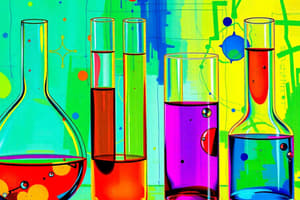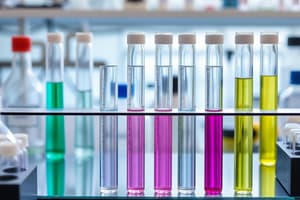Podcast
Questions and Answers
In gas chromatography, a sample of ______ compounds is injected into an inert gaseous mobile phase.
In gas chromatography, a sample of ______ compounds is injected into an inert gaseous mobile phase.
organic
The gaseous mobile phase in gas chromatography is known as the ______ gas.
The gaseous mobile phase in gas chromatography is known as the ______ gas.
carrier
Components in a sample are separated based on their ability to distribute between the stationary phase and the ______ phase.
Components in a sample are separated based on their ability to distribute between the stationary phase and the ______ phase.
mobile
Volatile compounds like petroleum hydrocarbons and ______ can be analyzed using gas chromatography.
Volatile compounds like petroleum hydrocarbons and ______ can be analyzed using gas chromatography.
Separation in gas chromatography can occur due to different ______ with column packing materials.
Separation in gas chromatography can occur due to different ______ with column packing materials.
The common inert mobile phases in gas chromatography include Ne, Ar, and ______.
The common inert mobile phases in gas chromatography include Ne, Ar, and ______.
The mobile phase velocity is usually within 25-150ml/min where as the flow rates for ______ columns are within 1-25ml/min.
The mobile phase velocity is usually within 25-150ml/min where as the flow rates for ______ columns are within 1-25ml/min.
A packed column is constructed from glass, stainless steel, copper or aluminum and typically 2-6 ______ long with a internal diameter of 2-4 mm.
A packed column is constructed from glass, stainless steel, copper or aluminum and typically 2-6 ______ long with a internal diameter of 2-4 mm.
Capillary columns are constructed from fused ______ coated with a protective polymer.
Capillary columns are constructed from fused ______ coated with a protective polymer.
The elution order in GC is determined by the solute’s boiling ______ and its interaction with the stationary phase.
The elution order in GC is determined by the solute’s boiling ______ and its interaction with the stationary phase.
Non-polar solutes are more easily separated with a ______ stationary phase.
Non-polar solutes are more easily separated with a ______ stationary phase.
Stationary phases in gas chromatography should be chemically inert, thermally stable, and have low ______.
Stationary phases in gas chromatography should be chemically inert, thermally stable, and have low ______.
For sample injection into a GC column, the sample must be ______.
For sample injection into a GC column, the sample must be ______.
In an isothermal separation, the column is maintained at a ______ temperature.
In an isothermal separation, the column is maintained at a ______ temperature.
A Thermal Conductivity Detector is based on the mobile phase’s thermal ______.
A Thermal Conductivity Detector is based on the mobile phase’s thermal ______.
A Flame Ionization Detector is used only for ______ compounds.
A Flame Ionization Detector is used only for ______ compounds.
The ECD consists of a beta emitter such as 63______.
The ECD consists of a beta emitter such as 63______.
The emitting electrons ______ the mobile phase which is usually N2.
The emitting electrons ______ the mobile phase which is usually N2.
When the eluted solute passes through the ECD, the electric current in the ECD ______.
When the eluted solute passes through the ECD, the electric current in the ECD ______.
ECD is a selective detector which is especially for solutes with ______ functional groups.
ECD is a selective detector which is especially for solutes with ______ functional groups.
ECD is used for ______ analysis.
ECD is used for ______ analysis.
Petroleum hydrocarbons are extracted from sea water and fractionated using Column ______.
Petroleum hydrocarbons are extracted from sea water and fractionated using Column ______.
Aliphatic hydrocarbon & Aromatic hydrocarbon fractions are produced using Column ______.
Aliphatic hydrocarbon & Aromatic hydrocarbon fractions are produced using Column ______.
GC-FID with capillary column and temperature programming with oven temperature hold for 20 min at 70 oC, then increase to 300oC with a rate of 8oC/______ and hold at 300 oC for 30 min.
GC-FID with capillary column and temperature programming with oven temperature hold for 20 min at 70 oC, then increase to 300oC with a rate of 8oC/______ and hold at 300 oC for 30 min.
The whole process will take about ______ hours.
The whole process will take about ______ hours.
ECD consists of a ______ such as 63Ni.
ECD consists of a ______ such as 63Ni.
The RSM is analyzed with the GC under the same condition set for the ______.
The RSM is analyzed with the GC under the same condition set for the ______.
Each solute undergo characteristic ______ into smaller ions.
Each solute undergo characteristic ______ into smaller ions.
The RT value and the intensity of peak are recorded for Qualitative & ______ Analysis.
The RT value and the intensity of peak are recorded for Qualitative & ______ Analysis.
The effluent from GC is introduced into the mass spectrometer’s ______ chamber.
The effluent from GC is introduced into the mass spectrometer’s ______ chamber.
Retention Value (RT) is measured in ______.
Retention Value (RT) is measured in ______.
A selective monitoring detector is used to detect the specific ______-to-charge ratio produced electricity current.
A selective monitoring detector is used to detect the specific ______-to-charge ratio produced electricity current.
Total Organic Carbon Analyzer is used in Analysis of organic substances in water and ______.
Total Organic Carbon Analyzer is used in Analysis of organic substances in water and ______.
In the ionization chamber, all molecules are ionized and they are separated by their mass to ______ ratio
In the ionization chamber, all molecules are ionized and they are separated by their mass to ______ ratio
Flashcards
Gas Chromatography (GC)
Gas Chromatography (GC)
A technique for separating organic compounds using a gaseous mobile phase.
Carrier Gas
Carrier Gas
An inert gas used to transport samples in GC.
Qualitative Analysis
Qualitative Analysis
Identifying the components in a sample.
Quantitative Analysis
Quantitative Analysis
Signup and view all the flashcards
Retention Time (RT)
Retention Time (RT)
Signup and view all the flashcards
Capillary Column
Capillary Column
Signup and view all the flashcards
Packed Column
Packed Column
Signup and view all the flashcards
Mobile Phase Velocity
Mobile Phase Velocity
Signup and view all the flashcards
Stationary Phases
Stationary Phases
Signup and view all the flashcards
Non-polar vs Polar
Non-polar vs Polar
Signup and view all the flashcards
Sample Injection Requirements
Sample Injection Requirements
Signup and view all the flashcards
Temperature Control in GC
Temperature Control in GC
Signup and view all the flashcards
Thermal Conductivity Detector (TCD)
Thermal Conductivity Detector (TCD)
Signup and view all the flashcards
Flame Ionization Detector (FID)
Flame Ionization Detector (FID)
Signup and view all the flashcards
Isothermal Separation
Isothermal Separation
Signup and view all the flashcards
GC-MS
GC-MS
Signup and view all the flashcards
Ionization Chamber
Ionization Chamber
Signup and view all the flashcards
Mass Spectrum
Mass Spectrum
Signup and view all the flashcards
Fragmentation
Fragmentation
Signup and view all the flashcards
TOC Analyzer
TOC Analyzer
Signup and view all the flashcards
Electron Capture Detector (ECD)
Electron Capture Detector (ECD)
Signup and view all the flashcards
Beta emitter
Beta emitter
Signup and view all the flashcards
Mobile phase
Mobile phase
Signup and view all the flashcards
Electronegative functional groups
Electronegative functional groups
Signup and view all the flashcards
Pesticides analysis
Pesticides analysis
Signup and view all the flashcards
Aliphatic hydrocarbons
Aliphatic hydrocarbons
Signup and view all the flashcards
Aromatic hydrocarbons
Aromatic hydrocarbons
Signup and view all the flashcards
Column Chromatography
Column Chromatography
Signup and view all the flashcards
Temperature programming
Temperature programming
Signup and view all the flashcards
Qualitative & Quantitative Analysis
Qualitative & Quantitative Analysis
Signup and view all the flashcards
Reference Standard Material (RSM)
Reference Standard Material (RSM)
Signup and view all the flashcards
Peak Intensity
Peak Intensity
Signup and view all the flashcards
FID Detector
FID Detector
Signup and view all the flashcards
External Standard
External Standard
Signup and view all the flashcards
PAH External Standard
PAH External Standard
Signup and view all the flashcards
Study Notes
Gas Chromatography (GC)
- A technique used to separate, identify, and quantify volatile organic compounds
- A sample of organic compounds is injected into a carrier gas
- The sample is carried through a packed or capillary column
- Components separate based on their distribution between the stationary and mobile phases
- Different types of columns (packed and capillary) exist, each with varying resolutions
GC Column Types
-
Capillary columns:
- High resolution
- Long, thin tubes (typically 10-60m in length, 0.10-0.53mm inner diameter).
- Often made of fused silica coated with a stationary phase
- Used for complex mixtures, multi-component analysis
-
Packed columns:
- Lower resolution
- Shorter, wider tubes (typically 2-6 meters long, 2-4mm inner diameter)
- Filled with a solid support material coated with a stationary phase
- Separates fewer components
GC Separation
- Separation based on intermolecular interactions between the sample components and the stationary phase
- Stronger interactions result in slower movement through the column
- Different rates of migration result in the separation of components
GC Detectors
-
Thermal Conductivity Detector (TCD):
- Measures differences in thermal conductivity between the carrier gas and the sample components
- Common, but not very sensitive
- Suitable for non-polar components
-
Flame Ionization Detector (FID):
- Measures the ions produced when organic compounds are burned in a flame
- Highly sensitive for organic compounds
-
Electron Capture Detector (ECD):
- Highly sensitive to compounds with electronegative functional groups (like halogens and nitrogen)
- Often used in pesticide analysis
GC-MS
- Combines GC and MS for comprehensive analysis
- GC separates compounds then MS identifies them by their mass-to-charge ratio fragmentation
- Mass spectrum provides qualitative information about the compound.
Additional Information
- GC-MS flow diagram shows the sequence of stages
- Various instruments are used for TOC (Total Organic Carbon) analysis
- Reference standards (such as EPA 16 Aromatic Hydrocarbons) are used for qualitative and quantitative analysis
- Sample must be volatile for injection
- Temperature programming is used to control the temperature of the GC column for good separation
Studying That Suits You
Use AI to generate personalized quizzes and flashcards to suit your learning preferences.





